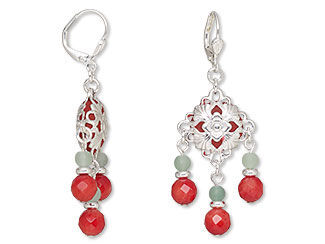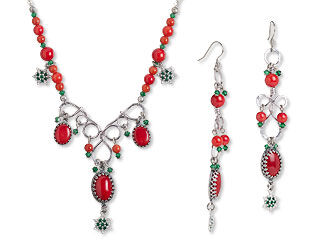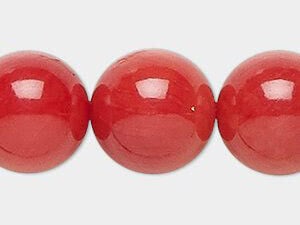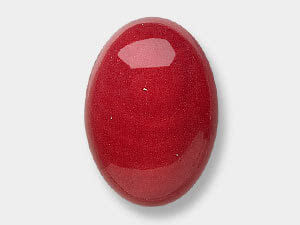Coral Meaning and Properties
Red Coral History
In many cultures, coral meaning is associated with protection, vitality and safe travel across water. Coral jewelry has been found in ancient Egyptian and prehistoric European burials and was especially popular during the Victorian age. Ancient Egyptians used coral pieces in tombs as protection against evil spirits in the afterworld, as it is believed to contain a drop of divine blood. There was significant trade in coral between the Mediterranean and India at the beginning of the first millennium.
The Gauls often used coral as ornamentation for their helmets and weapons, believing it was a protective stone. The Romans hung branches of coral around the necks of their children to protect them from danger. In the early 20th century, the people of Italy used coral for protection from the "evil eye" and as a treatment for infertility.
Precious coral or red coral is the common name given to Corallium rubrum and several related species of marine coral. In the trade, Corallium rubrum is sometimes referred to as "noble coral" and is considered to be the most desirable type of coral for jewelry.
Dive deeper into the magic of coral gemstones. Explore coral’s intriguing organic nature, far reaching historical wake and breadth of metaphysical benefits to discover what makes this undersea treasure so unique.

What are the Metaphysical Properties of Red Coral?
Coral is highly prized as a substance believed to be endowed with mysterious sacred properties. Coral meaning can include modesty, wisdom, happiness and immortality. It is commonly known to remedy spasms in the intestines, sleeplessness and bladder stones.
Coral can reduce stress and fears and combats foolishness, nervousness, fear, depression, panic and nightmares. Coral is used to attract success and wealth and strengthens foresight. Coral is a good aid for meditation or visualization.
What is Red Coral Made From?
Coral has been called the "garden of the sea" because it was once believed to be a plant. Instead, coral belongs to a small, but important group of organic gemstones. Coral is formed through a biological process rather than being a mineral with a crystalline structure like most colored stones. Precious coral is a deep-water coral that forms in rocky sea beds with low levels of sedimentation, typically in dark environments over 500 feet deep. Coral is slowly built by very small marine animals known as coral polyps. These tiny, soft-bodied creatures form with small, hard shells that accumulate as the colony grows. Over time, the colony begins to form complex branches and skeletal structures composed of hardened calcium carbonate and colored by carotenoid pigments. These formations grow very slowly, often as little as one millimeter per year, ranging in size from small, hand-sized structures to enormous coral reefs.
Coral is an organic material and is not an especially hard or durable gemstone, with a hardness rating of 3 to 4 on the Mohs scale. Precious coral is found throughout the world, but Torre del Greco (near Naples, Italy) has been the top coral trading center for over 200 years, processing nearly 75% of the entire world's supply of coral. Most coral is harvested from the western Mediterranean Sea, especially in Sardinia. Notable deposits are found in the Red Sea, Bay of Biscay, Malaysian Archipelago, Midway Islands, Japan, Taiwan, Australia and the Hawaiian Islands.
- Mineral Information: Calcium carbonate, magnesia and organic substance
- Chemical Composition: SaCO3
- Color: Deep red to soft pink
- Hardness: 3 to 4 (Mohs)
- Specific Gravity: 2.6 – 2.7
- Refractive Index: 1.486 – 1.658
How Do You Clean Red Coral?
Coral is very sensitive to acid and heat. Coral's color is known to fade with wear and tear. To prevent color loss, avoid exposing coral to direct sunlight for prolonged periods of time and avoid temperature extremes. Do not clean coral with harsh household cleaners, such as bleach or acid, and avoid spraying perfumes or hairspray on the stones.
Clean coral with a soft cloth and mild soap or detergent if needed. To prevent scratches, avoid wearing other gems in close contact with your coral jewelry. Store coral jewelry in a fabric-lined jewelry box or wrap in a soft cloth.
Red Coral FAQ
Q: Is coral a real gemstone or a fossil?
A: Coral is considered an organic gemstone, formed by marine invertebrates known as coral polyps. These tiny animals secrete calcium carbonate to build a hard exoskeleton, which accumulates over time to form coral structures. Because this material is created directly by living organisms rather than through fossilization—a process where minerals gradually replace organic material—gem-quality coral is not classified as a fossil. Fossil coral , formed by replacement of the natural minerals in coral with agate, is, however, a fossil—but it is no longer organic.
Q: Are coral beads considered ethical or sustainable?
A: Coral is strictly regulated in the United States and around the world. The Convention on International Trade in Endangered Species (CITES) requires permits for the international trade of coral to help protect vulnerable marine ecosystems. While harvesting wild coral can be environmentally harmful, sustainably farmed coral— including prized varieties like red coral—is available through responsible aquaculture. Always verify the source of any coral you purchase to ensure it comes from ethical and legal channels .
To read more about Fire Mountain Gems and Beads® commitment to sustainability, read “Natural Beauty.”
Q: What is the difference between natural and dyed coral?
A: Natural coral occurs in a wide range of colors, but in jewelry making, the harder red and pink varieties—such as Mediterranean, Pacific, Momo and Aka coral—are the most prized and are classified as precious gemstones. White coral, also a hard variety, is less common and is often dyed to enhance its appearance. Semi-precious corals, including bamboo coral and sponge coral , are more porous and often naturally beige or white. These types are frequently dyed to add vibrant color and visual appeal.
Q: Can coral be damaged by perfumes or lotions?
A: Coral is quite sensitive and can be easily damaged by perfumes, lotions and other chemicals. Always apply perfume or lotion prior to putting on coral jewelry, and avoid wearing coral jewelry during athletic activities, swimming and cleaning.
Designing with Red Coral
Coral is beautifully complemented by sterling silver beads and components. Pair with turquoise or amber for statement pieces and enjoy the style power of wearing red. Mix with similar shades of crystal beads for a magical look.
A Few Design Inspirations to Get You Started
Shop for Red Coral
**Please note that all metaphysical or healing properties listed are collected from various sources. This information is offered as a service and not meant to treat medical conditions. Fire Mountain Gems and Beads® does not guarantee the validity of any of these statements.
How did you like this resource? Your feedback helps us provide resources that matter to you most.
Copyright Permissions
All works of authorship (articles, videos, tutorials and other creative works) are from the Fire Mountain Gems and Beads® Collection, and permission to copy is granted for non-commercial educational purposes only. All other reproduction requires written permission. For more information, please email copyrightpermission@firemtn.com.





